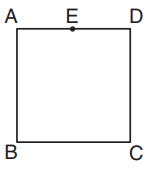shahar
Full Member
- Joined
- Jul 19, 2018
- Messages
- 505

The figure ABCD is a rectangle. E is the midpoint of the side AD.
Which answer from the following numbers cannot be the number of points of intersection of circle which center is E and rectangle ABCD?
(1) 1
(2) 2
(3) 0
(4) 4
I have 3 questions:
a) Can I prove the answer with the geometry tool using axioms? Which are the axioms?
b) Can I prove it by another tool/s?
c) Can I prove the answer by proof by contradiction (reductoi ad impossibile)?
Happy day!
